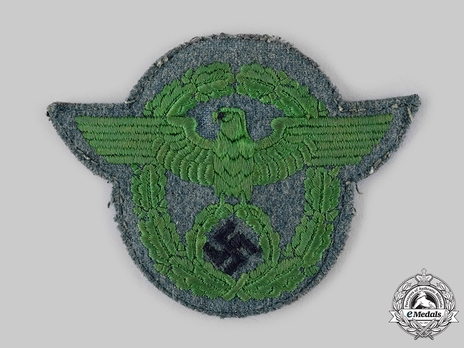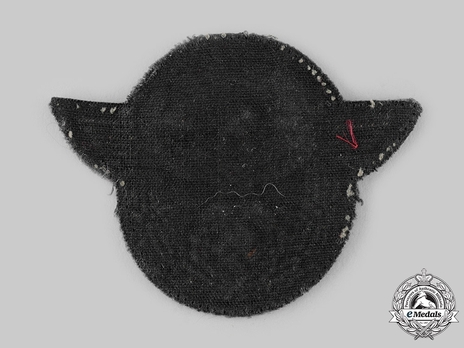German National Police NCO/EM Ranks Sleeve Eagle (cut-out)
CATEGORY: Version
SKU: 52.GOR.03.02.03.02.001.001
Estimated market value:


Estimated market value:
Constructed of field-grey wool twill, the obverse bearing a machine-embroidered green Schutzpolizei insignia, unmarked, measuring 95 mm (w) x 72 mm (h), in near extremely fine condition.
During the Third Reich, an effort was made to unite all of Germany’s disparate provincial police forces and agencies into a single cohesive national unit. To attain this goal, Reichsführer-SS Heinrich Himmler was named Chief of the German Police in the Ministry of the Interior in June 1936. That same month, Himmler implemented new standardized uniforms, headgear, and insignia. The uniforms worn prior to Himmler’s appointment were often navy blue, particularly in what had been Prussia. The new uniforms were green, in a shade that was then dubbed “Police green”.
The German Police were divided into two main units, the Ordnungspolizei (Orps or Regular Police) and the Sicherheitspolizei (Secret Police); the Ordnungspolizei were unofficially called the green police (Grüne Polizei) as a result of their uniform colour. The Sicherheitspolizei were made up of two main organizations, the Gestapo and the Kriminalpolizei (Criminal Investigation Police). At the beginning of the Second World War, the Sicherheitspolizei were brought under the auspices of the Reich Main Security Office.
The Ordnungspolizei was also divided into smaller branches of service, and each branch was associated with a branch of service/troop colour (Truppenfarbe). The troop colours include:
Schutzpolizei des Reichs (National Protection Police): Green
Schutzpolizei der Gemeinden (Municipal Police) pre-1942: Red
Schutzpolizei der Gemeinden (Municipal Police) post-1942: Green
Gendarmerie (Gendarmes/Rural Police): Orange
Verwaltungspolizei (Administrative Personnel): Light grey
Feuerschutzpolizei (Fire Protection Police): Carmine (on dark blue)
Wasserschutzpolizei (Water Protection Police): Yellow (on dark blue)
Verkehrspolizei (Traffic Police): Bright red (on white)
The Police Sleeve Eagles were introduced in 1936. They were worn on the upper left sleeve of uniform garments and used to identify policemen and their rank groups.
The insignia is made of embroidered cloth. It is round or oval in shape, or it comes in a cut-out shape with the eagle’s wings extending over the sides. Sleeve eagles for Officers usually came in the cut-out shape. The cloth backing is in the colour of the uniform the insignia was sewn to.
The insignia features an eagle, facing to the viewer’s left, sitting on a wreath with a swastika inside, while the eagle and the wreathed swastika are positioned within another wreath, with the eagle’s spread wings extending beyond the wreath.
The eagle’s feathering is usually in six rows for Non-Commissioned Officers (NCOs) and Enlisted Men (EMs), and in three rows for Officers.
The insignia for Officers of General rank feature gold-coloured (gilt) bullion wire, and the non-General ranked Officer insignia feature silver-coloured (aluminum) bullion wire. The swastika is usually in black.
Insignia for NCOs and EMs feature machine-embroidered wool or rayon thread, the colour of which matches the wearer’s service colour. The swastika is usually black, except for Fire/Water Protection Police (carmine and yellow, respectively) and Armored Police (for which the embroidery, including the swastika, is green on a black cloth backing).
Prior to November of 1941, the badges worn by NCOs and EMs also featured an inscription above the eagle, either arched or in a straight line, in the same colour as the eagle, identifying the wearer’s service location. An exception to this rule was the administrative branch.
The only branch of service that continued to include this information on its eagle badges post-1941 was the Fire Protection Police.

Comments
Sign in to comment and reply.


Scroll Top